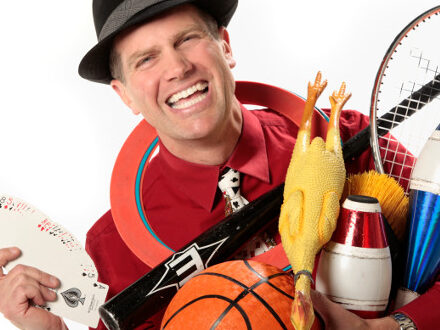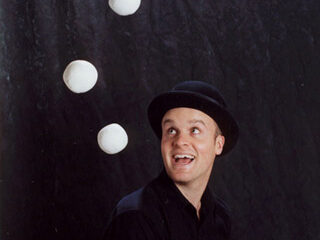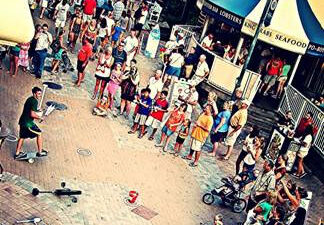About Juggling
According to Webster’s Dictionary, a juggler is one who performs tricks or acts of magic or deftness; one who is skilled in keeping objects in motion in the air at the same time by alternately tossing and catching them.
Juggling goes back many hundreds of years. Egypt imported the art of juggling from India. There are frescos from ancient Egypt that show female jugglers. It has been an institution for many centuries in Iran, China, Japan, Southeast Asia, and Tibet. In the East, shamans and priests predicted the future, explored the unknown and diverted danger through juggling. Greeks and Romans and later Native Americans loved jugglers. Aztecs have made sculptures of people juggling using their hands and feet. In these early societies jugglers often participated in the religious and mythological rituals.
According to Marcello Truzzi, by the early nineteenth century juggling had become specialized. On October 5, 1819, an ad in the Salem Gazette described the East Indian Ramo Samee as having performed in England and for all the crowned heads of Europe, “who pronounced him to be the first master of the art in their dominions.” The article said he included “a Series of Evolutions, with four hollow brass Balls, about the size of Oranges; stringing beads with his Mouth, and at the same time, as he balances, turning Rings with his Fingers and Toes; and manly activity in throwing a ball, the size of an eighteen-pound shot, to different parts of his body with the greatest of ease.” Samee may be the earliest recorded “modern” juggler, predating the Chinese juggler, Lau Laura, who performed at Drury Lane in 1832 and who was previously considered the first.
The early jugglers were called weight jugglers. These jugglers specialized in the manipulation of heavy objects, for example, cannonballs. One of the great weight jugglers, Paul Spadoni, born in 1870, would enter the ring on a chariot dressed as a Roman. He would then release the horses and balance the chariot on his head! Another trick he did was to drop a cannonball on a springboard which would send another ball in the air, and he would catch the ball in flight on the back of his neck. Today weight juggling is almost obsolete.
The second popular form of juggling was salon juggling. The salon juggler usually juggled such objects as his top hat, gloves or cane, as well as articles from the drawing room, such as flower bouquets, billiard balls and cues. Kara, an early German juggler, was a great early salon juggler. Adanos, also from Germany, is one of the great modern salon jugglers.
The third form of juggling was equestrian juggling. Here performers would juggle while standing on the back of a moving horse. Briatori was the first (and perhaps the last) to juggle seven balls while standing on a moving horse. Other great equestrian jugglers were Nicolai Nikitin (son of the famous Russian circus owner) and Enrico Truzzi, father of Massimiliano Truzzi.
The fourth form of juggling is antipodist juggling. An antipodist juggles objects with his feet. Often this form of juggling is combined with acrobatics, with one performer “juggling” the other with his feet while the other performs somersaults. These performers are usually called icarians. The best icarians have been Europeans, especially Germans and Hungarians.
The fifth form of juggling is group juggling. This occurs when more than one person juggles the same objects back and forth. A famous French family group, the Perezoffs, at one time consisted of 11 jugglers. A fine German group was the Amoros family. One of their troupe was the first to juggle nine balls at one time. Today most jugglers work as singles or duos.
The early specialized schools of juggling dissolved in the early 1900’s. The weight and equestrian jugglers are no longer seen, group juggling has diminished and there are fewer antipodists, but there are still quite a few icarians and salon jugglers left.
The greatest juggler in the world was Enrico Rastelli, who was born in 1896. Enrico practiced juggling from six to twelve hours most days. He would often talk with performers and conduct business affairs while juggling. He was the father of ball juggling – the physical manipulation of inflated rubber balls. Ball juggling includes such feats as spinning the ball on the fingers, bouncing it continuously on the head, and throwing and catching the ball with various parts of the body. Rastelli would also throw the ball into the audience, have them throw it back and catch it on a stick he held in his mouth. He could carry on an extended conversation while bouncing two balls on his forehead!
In addition, he could juggle eight plates while balancing a tall object upon his forehead! This feat has never been duplicated. He was also the first, and one of very few, jugglers to juggle six plates while simultaneously bouncing a ball continuously upon his forehead.
The golden age of Vaudeville brought jugglers from the streets, circuses and jails to theatres. Vaudeville died with the advent of movies, and juggling diminished until the International Jugglers Association (IJA) was founded in 1947. After about twenty years a man named Hovey Burgess started teaching everyone he met to juggle. His students taught others, and a juggling boom spread across the USA.
Today, jugglers entertain and work nationwide and internationally. Although the history of juggling is long and varied, it still hasn’t gone out of style! People around the world continue to gather in awed crowds to watch a professional juggler defying gravity.








